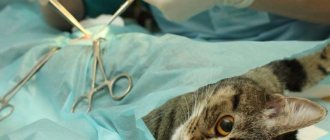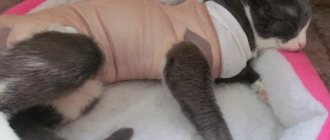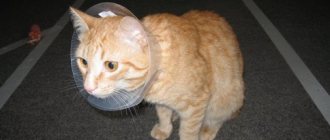May 19, 2020
Castration is a surgical procedure during which a veterinarian removes the testes from a cat. However, this procedure can be performed without surgery.
To understand all the intricacies, you need to learn more about the types of procedures and methods of implementation.
Should a cat be neutered? Pros and cons of the operation
Pet owners think about the sterilization procedure after young cats begin to mark their territory. The main advantage of castration is the disappearance of the desire to mate. However, the operation has many other advantages:
- Elimination of aggressive, restless behavior. The testes produce special hormones that force the cat to look for females and defend its territory from strangers. Even if the animal lives in an apartment and has never seen other cats, the owners may notice the pet’s constant anxiety. If two males meet in the same territory, fights will begin. Excessive testosterone production can lead to the cat attacking its owners.
- Prevention of diseases. After castration, a cat will not develop a testicular tumor, since this organ will be completely removed.
- Reducing the risk of the animal running away. Even if a cat is very attached to its owners, the natural instinct of reproduction can take precedence over reason. The animal will try to escape every time it smells a female. Domestic cats are poorly adapted to outdoor life. After castration, the animal is unlikely to want to leave a comfortable and safe place.
- Elimination of unpleasant odors. Kittens' urine does not have a strong odor. During a cat's puberty, a special secretion is mixed into the urine. Hormones force the male to “mark” his territory and attract females. People find this scent very unpleasant. After castration, the cat's urine will not have a strong odor. The pet will only go to the litter box and not mark any surfaces in the house.
- Increased life expectancy. According to worldwide statistics, neutered pets live longer. They do not experience stress from heat. This makes their nervous system calmer.
Castration, like any other surgical operation, has its drawbacks. It has been proven that castrated cats become passive. Lack of activity leads to obesity, which in turn contributes to the development of diabetes, urocystitis and urolithiasis, and also provokes joint problems.
Fortunately, most unpleasant complications can be prevented by providing the animal with proper nutrition. In any case, the benefits of castration outweigh any possible disadvantages. The main thing is to entrust the health of the animal to an experienced veterinarian.
What kind of food should a cat have in the first postoperative days?
All food should be familiar to the pet, and it should be given in semi-liquid form so as not to burden the gastrointestinal tract. In this case, regular portions should be halved.
Is it possible to feed a neutered cat fatty foods these days? No way! Products such as sour cream, fatty fish or meat should be excluded from the diet.
When should a cat be neutered?
There are no strict deadlines for castration of cats. Most specialists do not perform surgery on kittens under four months of age. Optimal time for surgery: 6-9 months.
Castration of a cat at an early age
Veterinarians do not recommend sterilization for cats under six months of age. But if the cat shows signs of sexual activity earlier, then castration will be carried out immediately after the animal reaches five months of age.
Surgeries at an early age will not affect weight loss or skeletal underdevelopment. These features are laid down in the genotype, which determines the constitution of the pet.
Carrying out surgery at the age of 7-9 months
It has been proven that cats that have reached the age of 6-9 months tolerate castration best. The animal enters adolescence and begins to show interest in females. The cat may start meowing throughout the day. It is at this age that a pet experiences a hormonal surge, which is negatively reflected in the smell of urine.
The cat also gains sufficient body weight to tolerate anesthesia normally. Some veterinarians advise bringing your cat for surgery long before physiological changes develop.
Carrying out surgery in adulthood
Young cats under 3 years of age tolerate castration quite well. However, it is worth considering that adult males who are already accustomed to marking territory can continue to do so even after castration. It will take at least a month to level out your hormonal levels.
About 5% of animals will continue to mark territory for the rest of their lives. Also, some castrated “untied” cats may try to have sexual intercourse with a female. Veterinarians consider this behavior to be a habit: the cat is simply repeating already established patterns.
Technically, cats over 3 years old can also be neutered. However, in adult animals the risks of anesthesia increase. Such an animal must first be examined: undergo blood tests and undergo a screening ultrasound of the heart.
The most popular and recommended cat food brands
Sterilization radically changes the life of a pet and its habits. If earlier your cat urgently demanded a walk and was looking for a cat, now he is only interested in food. A cat that eats excessively high-calorie foods will begin to gain weight, and this is already a bad sign for the animal. To keep his figure normal, choose the right food!
The range of cat products includes two main types of food: dry and wet. They differ in composition and cost. If the owner chooses the first option, it is necessary to provide the animal with constant access to drinking water.
Which food is better, dry or wet, is up to you to decide; there is no clear answer to this question. The main thing is to choose a fresh composition of proven quality with mandatory certification, giving preference to reliable brands. Experts do not recommend choosing budget food. Such savings can negatively affect the health of the animal.
Premium class food
Experienced breeders recommend giving preference to the following brands:
- Hills – a large assortment of therapeutic and prophylactic products that help prevent obesity in animals;
- Royal Canin - nutritional composition rich in vitamins;
- Purina PRO PLAN is a balanced food with pribiotics that improve intestinal function.
Preparing a cat for castration
The most important rule for the owner: remain calm throughout the entire period of preparation for the operation. Pets understand human emotions very well. The pet will feel anxious and begin to hide and behave aggressively. It is necessary to maintain a fasting diet for 6-8 hours before anesthesia. Water can and even should be left available.
If castration will be carried out by a veterinarian who has not previously examined the cat, it is necessary to prepare information about vaccinations, medications and diseases that the animal has suffered. The owner will also be asked to sign a consent form for the use of anesthesia, an information sheet regarding possible complications after the operation.
Feeding a castrated cat natural food
So, successful castration of the cat is behind us, care after the operation is the next step for the animal’s quick recovery. If your furry friend is accustomed to natural food, you should not suddenly change your taste preferences. Continue to pamper your pet with the usual foods, only in smaller quantities and with some restrictions.
Useful natural for neutered pets:
- Fermented milk products with a small percentage of fat content.
- Boiled and raw vegetables (approximately 15% of the total diet). You can combine these products with meat dishes.
- Raw lean meat, previously frozen. This product can also be served lightly boiled.
- Raw quail eggs.
- Liver, kidney, hearts and other offal (boiled or raw, without spices and salt).
- Small portions of porridge made from buckwheat, rice and oatmeal.
- Chicken bouillon.
- Sometimes you can give fruit in small quantities.
Make sure your cat always has clean water in his bowl to drink. Rinse the bowl regularly to remove food debris. Do not overfeed and do not be lazy to cook separately for your four-legged friend. Proper care after sterilization is the key to a long and happy life for your furry family member!
More information about sterilization can be found here
Anesthesia for castration of a cat
To choose the optimal method of pain relief, the veterinarian will examine the cat and take measurements of vital signs:
- temperature;
- heart rate;
- blood pressure.
The veterinarian will perform surgery only if he receives confirmation that the cat is healthy enough to recover from anesthesia.
Most often, the animal is sedated using an injection. An intravenous catheter is inserted through the shaved area of the paw.
Inhalation anesthesia
Most cats are given anesthetics by injection or intravenous catheter. After falling into a light sleep, the anesthesiologist will insert an endotracheal tube through which anesthetic gas will be administered.
The animal will also be connected to equipment that monitors heart rate, breathing, and blood pressure. Most veterinary clinics use an inhaled drug - isoflurane or sevoflurane.
Non-inhalational anesthesia
The most common type of sedation and analgesia is a combination of drugs. The operation to remove the testes is quite simple and takes approximately 10-15 minutes.
Most often, this manipulation uses a combination of a sedative intravenous drug and a local anesthetic, which is injected directly into the testes themselves for pain relief.
Should a cat be spayed: indications for surgery
The behavior of an unsterilized domestic cat during the period of heat can be quite aggressive, accompanied by restless meowing, loud screaming, and the pet’s desire to escape from the house. The consequences of this may be mating with street animals, unwanted offspring for owners, infectious diseases, injuries, etc.
Sterilization will help to avoid these troubles - during this operation, the cat's fallopian tubes are tied. The main risk during sterilization is anesthesia, so the operation should be performed in a good veterinary clinic with experienced specialists.
Indications for cat sterilization:
- preventing unwanted pregnancy and unwanted behavior associated with estrus;
- prevention of the development of pathologies (tumors of the mammary glands and uterus);
- purulent inflammation of the uterus;
- tumor of the ovaries or uterus.
Methods of castration of cats
There are several options for sterilizing males. In modern veterinary clinics, testes are most often removed surgically. However, some systemic diseases may make any intervention impossible.
Nuances of classical surgery
After administering anesthesia, the surgeon will make two incisions directly on the animal's scrotum. Next, the specialist removes the testes, placing biological nodes on the blood vessels. The incisions are treated with an antiseptic solution. Sutures, as a rule, are not applied.
Medical (chemical) castration
If anesthesia or sedation is contraindicated, your veterinarian may administer medications to stop testosterone production. The advantages of this method include reversibility and low risk of complications.
Chemical castration involves inserting an implant under the cat's skin. The testes gradually atrophy, that is, decrease in size. The animal's behavior will change within 4-5 weeks after the procedure. The duration of the effect varies from 6 to 12 months.
After the end of the implant, the production of hormones is restored, which also leads to the return of the size of the testes and the manifestation of sexual desire.
Features of castration of a cryptorchid cat
If one or two testes do not descend into the scrotum, the cat is diagnosed with cryptorchidism. The shedding process must be completed before the kitten is 6 months old.
The nuances of the operation directly depend on the location of the testes. They may be located under the skin or in the abdominal cavity. If one or both sex glands remain in the abdominal cavity, then to perform the removal procedure, abdominal surgery is performed through one incision.
Everything you wanted to know about castration.
Castration of cats is perhaps one of the most common surgical interventions in modern veterinary medicine. According to many experts, this operation is indicated for all animals not used for reproduction. In addition to the advantages in everyday life (silence in the house, not interrupted by the “songs” of a loving pet, the absence of an unpleasant odor and the bad habit of marking its territory), castration also protects your pet from many health problems inherent in uncastrated older animals: endometritis, pyometra, breast tumors and prostatitis. In this article we will consider the issues that most often arise during this operation.
Castration of a cat, how is the operation performed?
The essence of the operation is the direct removal of the testes, that is, the male gonads. The duration of the operation is from 5 to 10 minutes, depending on the characteristics of the patient, the method of operation and the qualifications of the surgeon. The most common way to perform this operation is as follows: the surgeon dissects the skin of the scrotum, opens the common vaginal membrane, isolates the spermatic cord and artery, and connects them together (i.e., applies a biological knot). After which the testis is cut off, the ligated ends of the artery and cord are set into the cavity. The procedure is completed! Sutures are not placed on the scrotum; additional treatments are recommended by the surgeon, depending on the characteristics of keeping your animal. Complete healing occurs 3-7 days after surgery. The optimal age for castration is from 4 to 8 months (older animals have stable hormonal levels and manage to acquire “bad” habits, which are subsequently difficult to correct).
Why does a five-minute procedure cost the animal owner so much money and why do doctors insist on performing the operation in a clinic, and also often recommend leaving the animal in the hospital for the recovery period? Let's try to figure it out.
Why so expensive?
No matter how simple this procedure is from a technical point of view, we are talking about surgical intervention using anesthesia and general and local anesthesia. Even if you have a young and healthy animal, it is important to correctly carry out the premedication procedure, that is, prepare for putting the animal under anesthesia. If the animal belongs to a risk group (old age, concomitant diseases, breed predisposition), it is recommended to conduct additional studies, such as: general and biochemical blood tests, ultrasound of the heart. Don't forget that using anesthesia is always a risk. Further, anesthesia, its depth, quality and safety depend on the drugs used. In our clinic, anesthesia is selected individually for each animal in order to minimize the risk of unwanted effects on the body. But, even if all of the above conditions are met, one should take into account the possibility of an allergic reaction to a particular drug, as well as other undesirable reactions of the body; unfortunately, no one is immune from this. And in this case, in order to quickly remove the patient from this condition, as well as to minimize the consequences and maintain the vital functions of the body, often, in addition to a qualified specialist, the use of additional medications and sometimes special equipment is required. But even with an ideal course of the entire operating period, the animal’s recovery from anesthesia requires a certain amount of time. No responsible veterinarian will allow an animal to go home in an unstable condition after surgery. Providing comprehensive postoperative care is an important point that significantly influences the animal’s recovery process after surgery. That is why your pet should spend some time after the operation under the supervision of doctors. They will determine the adequacy of the animal’s condition, individual characteristics and, in case of unforeseen situations, will be able to promptly provide the necessary assistance. In addition, in the postoperative period, antibiotics and immunomodulatory drugs are often administered to the animal, because after surgery, during the recovery period, the body is especially vulnerable and susceptible to adverse environmental factors.
Considering all of the above, we can draw the following conclusions: the low cost of the procedure may indicate the lack of high-quality and safe medicines and equipment for this procedure or the low qualifications of the specialist, which, accordingly, increases the risk of complications in your pet during the operation or during postoperative period.
Does an adult animal need to be neutered?
“At what age is it best to castrate?” This question inevitably arises for any happy owner of a representative of the cat family. The opinion of veterinary specialists on this matter is unanimous: if your pet does not participate in breeding and does not have constant access to females, it is better to carry out the castration procedure before the onset of puberty, that is, up to a year. In this case, the immediate risk of the procedure is reduced, the problem of the emergence and consolidation of “undesirable” behavior associated with puberty is eliminated, and also prevents the risk of developing many diseases of various organs and systems.
However, there are different life situations, in one case the animal may appear in your home having already reached the age of puberty (picked from the street, brought from a nursery, bred), in another - the operation was not performed at an early age for various reasons (not " marked” the territory, but “asked for a cat”, they wanted to keep it for breeding work), there are also cases of castration of an adult animal for medical reasons. In any case, you are faced with the problem of castration of an adult animal. What to expect from the operation? Does the risk of complications increase during surgery and during the postoperative period? How to properly prepare for this procedure? These and many other questions immediately arise before the owner. And now we will try to answer them.
What is the difference between castrating a young cat and castrating an older cat?
The first thing to remember is: the older the animal, the higher the risk of complications when putting the animal under anesthesia and removing it from it. Therefore, try to carefully prepare for this event. Consult a specialist and, if necessary, conduct additional studies (ultrasound of the heart, clinical and biochemical blood tests, urine analysis, etc.). We strongly recommend that you abandon the idea of “castration at home,” as this entails additional risks. The older your animal is, the more carefully the preparation for the operation should be carried out and the more responsible the place for it to be chosen. Since, if unforeseen complications occur, the surgeon and anesthesiologist must have the necessary medications and equipment on hand to assist your animal and carry out resuscitation measures.
There is one more, important point. Often, adult cats are brought in for castration due to problems associated with the animal's behavior. The most common complaints: marking territory, “yelling” at night, as well as excessive aggression of the furry pet.
You should not hope that after the operation, upon returning home, your cat will immediately stop marking his territory, begin to sleep quietly at night and completely change his attitude towards life.
Hormones secreted by the gonads circulate after castration and affect the body for about a month after surgery. Therefore, their effect will fade away gradually, and the behavioral reactions caused by them will also gradually fade away. In addition, these manifestations of sexual desire, over time, can become fixed in the status of a habit, which requires correction using educational methods. Also, do not forget that the smell of cat urine is very difficult to completely remove, especially from furniture, clothing and tiles. The presence of smell only aggravates the entrenchment of unwanted behavior (simply put, your cat doesn’t understand why he can’t pee on the sofa, because it smells like his toilet, and he sincerely believes that he is doing everything right). In this case, to correct the situation you will need specialist advice and patience.
Another unpleasant manifestation of sexual heat is often the increased aggression of the animal towards the people around it. Castration helps reduce an animal's aggressiveness, but only if the aggression is a consequence of excessive sexual arousal. If your animal is aggressive by nature, surgery, unfortunately, will not help you much.
There is another side to the problem. Many pet owners are afraid that after castration their cheerful and active cat will turn into a kind of fat, lazy hulk, for whom the only entertainment in life will be to eat and walk to the toilet. This idea of the life of a castrated cat is wrong. Of course, after the operation your cat will become calmer, but only due to the cessation of the release of sex hormones into the blood; otherwise, he will remain the same. About a month after castration, the appetite may increase, but if you follow the rules of a balanced diet, as well as exercise, your pet will not be at risk of obesity. After the operation, we recommend that you consult a veterinarian; he will answer all your questions and help you choose a diet and exercise regimen that is appropriate for the age and physical condition of your pet.
Sterilization of a cat.
Very often, veterinarians are asked the question “What is the difference between castration and sterilization and which term is correct to use?” Castration is an operation that involves removing the gonads to prevent fertilization. Sterilization is a process in which an animal is deprived of the ability to reproduce, while the gonads (and, accordingly, all instincts) are preserved. In previous years, the method of sterilization (tubal ligation) was practiced in veterinary medicine; this procedure is not used in modern veterinary medicine. So the term “cat sterilization” is used more out of habit than reflects the essence of the surgical intervention.
In this section we will try to answer the most frequently asked questions related to this procedure. However, do not forget that reading this article will not replace your consultation with a specialist who will be able to take into account all the individual characteristics of your pet.
Optimal age for surgery.
Veterinary experts consider the best age for this operation to be from 4 months to a year. Despite this, this operation can be performed at an older age.
How long does it take to recover after surgery?
Restoration of all body functions occurs on the 2nd day, complete healing of the postoperative wound occurs on 10-14 days after surgery. Remember that these numbers are not absolute indicators; everything depends on the individual characteristics of the patient.
How is this type of surgery performed?
Castration of a cat is an abdominal operation. Even under such terms as “sterilization without stitches and blankets”, “minimally invasive method”, a single essence is hidden - it is impossible to castrate a cat without penetrating the abdominal cavity. The difference in these methods is only in the size of the incisions and the equipment for the procedure. When castrating a cat using endoscopic equipment, the incisions are small and often do not require sutures; when performing a manual operation, the length of the wound will depend on the surgeon and the condition of the tissues and organs of your cat.
The essence of the operation, as with castration of a cat, comes down to the removal of the cat's sex glands - the ovaries. After entering the abdominal cavity, the surgeon finds them, applies ligatures and excises the ovaries. After which sutures are placed on the abdominal wall.
Is it necessary to remove the uterus when spaying a cat?
No, removal of the uterus is not a mandatory procedure when castrating a cat, however, if there are visible pathologies of this organ, surgeons usually remove it during the operation so as not to risk the patient’s health.
What anesthesia is used for this operation?
In our clinic, for any surgical intervention, multi-level anesthesia is used, which is selected strictly individually, taking into account the characteristics of each individual patient. When carrying out sterilization, it usually includes: premedication - preparing the body for the effects of the drug, inhalation anesthesia, epidural anesthesia. The surgeon will tell you more about the drugs and methods after a detailed examination of your animal.
Which stitch is better, removable or cosmetic?
A cosmetic suture is an intradermal suture made using absorbable suture material. The essence remains the same, so your cat will not notice much of a difference, however, we recommend, if the condition of the skin allows, to make an intradermal suture. Since it does not require treatment and, importantly, you do not have to bring the animal back to the clinic to remove stitches, that is, you will avoid an additional visit to the clinic, and your animal will avoid another stressful situation. Many experts believe that when performing an intradermal suture, there is no need for a blanket, however, the veterinarians of our clinic recommend leaving the animal in a blanket for at least a week for additional protection and to prevent self-injury during the healing process.
Is it possible to do without surgery? Is it safer to give pills?
You can do without surgery if you are not bothered by the animal’s behavior during the heat period. However, regarding drugs to prevent heat, veterinary specialists around the world say a categorical “no”. The effect of drugs of this type: “Contrasex”, “Sex Barrier”, etc., consists in administering a “shock dose” of hormones to the animal’s body, disrupting the natural course of the sexual cycle and, accordingly, causing the cessation of estrus. However, such a “hormonal explosion” cannot pass without leaving a trace on the animal’s body. Regular use of hormonal drugs to suppress sexual desire often leads to the occurrence of diseases such as endometritis, pyometra, polycystic ovary syndrome, infertility and even breast tumors. The outcome of all these diseases is the same - the operating table. However, it is one thing to bring an absolutely healthy animal, properly prepared for the procedure, to surgery, and quite another thing to undergo an emergency operation for medical reasons, when it is a matter of life and death.
What are the consequences of the operation? Will the cat's behavior change? Is special post-operative care required?
One of the main consequences of this operation is the cessation of “concerts” of your cat during the period of sexual heat, which simply will not happen. Often, after surgery, animals become calmer due to the disappearance of hormonal increases and sexual desire. In general, your cat’s life will not change.
No special postoperative care is required, other than wearing a protective blanket. All necessary measures are carried out in the hospital, where the cat remains for several hours after surgery.
Do all cats get fat after sterilization?
No, sterilization can only indirectly affect the process of obesity. Since after the operation the animal will lead a more sedate lifestyle, it is worth adjusting its diet by reducing the amount of protein and calories consumed. In addition, any animal, regardless of status, needs regular exercise. If you follow these simple rules, your pet will not be at risk of obesity.
In this article we tried to answer the most frequently asked questions about castration of cats. However, reading this article does not replace an examination by a veterinarian, since all animals are individual. For further advice, please contact your veterinarian.
Possible complications after surgery
Surgical removal of the testes is a fairly simple operation, but in rare cases complications can occur. Veterinarians usually assess the animal’s health before the procedure begins and inform the owner about the possible development of the following side effects:
- licking of incisions on the scrotum and inflammation of wounds
- deterioration of general condition
In order to prevent the development of complications, it is necessary to monitor the cat during the first 24 hours after surgery and follow the recommendations of the veterinarian.
Coming out of anesthesia
Usually, the operated animal is discharged from the veterinary clinic only after waking up, but sometimes it is more convenient to pick up the cat immediately after the operation in order to transport it home while it sleeps. In any case, keep in mind that anesthesia lowers body temperature, so your cat will need warmth after surgery.
. If you plan to pick her up right away, place additional bedding on the bottom of the carrier and prepare a blanket in advance. Sometimes a heating pad may be needed. If the owner does not have one, you can use a plastic bottle with warm water wrapped in a diaper.
After receiving the sleeping cat from the hands of the veterinarian, lay it on its side and cover it with a blanket.
The eyes of a cat under anesthesia may be slightly open. This is fine. To prevent the cornea from drying out, you can occasionally instill saline, artificial tears, or gently close the cat's eyelids with your fingers. When the animal begins to wake up, the blink reflex will be restored. /p>
Do not rush to leave the veterinary clinic: it is safer and more reliable to wait for the cat to completely recover from the state of anesthesia under the supervision of a veterinarian. Once you get home, place the cat on the floor, on a bedding or bed, in a warm, quiet place, away from doors and drafts.
Place the litter tray close to the bed.
How to care for a cat after castration
After the operation, the doctor will give individual recommendations based on the animal’s condition. However, the standard set of care instructions is approximately the same.
- Provide constant supervision to your pet. If the operation is successful, full recovery of health will take only 1-2 days. It is advisable to keep an eye on the cat until complete rehabilitation. It is important to exude confidence and remember to pet and encourage your pet.
- Place a protective collar around the cat's neck. It is very important to ensure that the cat does not lick the incision area. An Elizabethan collar will prevent the animal from licking the damaged area. Treatment of wounds is usually not required.
- Provide the animal with water and food. You can feed him wet food after surgery, since the cat was previously on a starvation diet. To get him interested in food, it is best to give him a bag of wet food or canned food for neutered cats. This will quickly replenish the balance of micro and macroelements.
Wound care
In summer, the chances of catching a dangerous infection are much higher, since warmth is a haven for bacteria. To avoid infection of your pet in the summer, he needs to undergo a 5-day course of antibiotic treatment.
It is also necessary to purchase a special collar for the cat that prevents the animal from licking itself. It would seem that licking wounds is characteristic of animals and usually helps them. But not in case of castration. A hard cat's tongue can remove stitches and introduce infection into the wound.
The suture area can be treated with hydrogen peroxide, brilliant green or Levomekol ointment. Every morning and evening, check the cat's groin area and check for bleeding or other suspicious phenomena.











